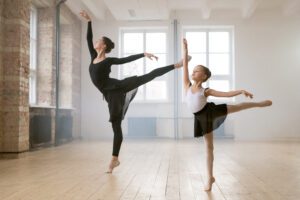Milda Luckute, a former Royal Ballet School student, is now a corps de ballet dancer at Semperoper Ballett in Dresden.
She joined the School in 2020 and graduated in 2023, earning The London Ballet Circle Dame Ninette Award for being the most outstanding female graduate of her year.
Here, Milda shares her insights into her transformative experience at The Royal Ballet School and how it shaped her career as a professional dancer.
Milda’s Journey to Training at the School
Milda began ballet at age five, inspired by Royal Ballet School dancers like Darcey Bussell, Carlos Acosta, Marcelino Sambé, and Zenaida Yanowsky, who later became Milda’s teacher at the School. Milda was “mesmerised by their quality, dynamics, and very distinctive style.”
At 14, Milda attended the School’s Summer Intensive at White Lodge in Richmond Park. Each year, students from around the world attend the Intensive to receive top-tier coaching from the School’s Artistic team and guest teachers.
Milda “absolutely fell in love with the teachers, the style, [and] the repertoire” she encountered at the two-week Intensive. Despite considering it an “ambitious and unrealistic dream,” she knew she wanted to train at the School. “Deep inside of me there was a feeling that if I work hard enough there is a chance that it might become true,” Milda says.
A few weeks later, the School invited Milda to visit Upper School on a short-term scholarship. Those three days only deepened her desire to train there. The School invited her to a final audition in 2019, but she wasn’t successful.
Milda later understood that the School’s decision not to accept her at that time was the right one. “I was a year younger than the other applicants,” she says. “I simply would not have been physically able to cope with the pace of learning and probably would have risked potentially compromising my health.”
Once Milda’s initial disappointment subsided she became “even more motivated.” One year later, she took part in the Prix de Lausanne, an international ballet competition for young dancers. Impressed by her performance, the School invited Milda to join Upper School as a full-time student.
How Milda’s Royal Ballet School Training Shaped Her as a Dancer
Milda says her Royal Ballet School training “fundamentally” shaped her as a dancer: “Each day I was gaining something new and unique, which was moulding me and my own understanding of dance immensely.”
Milda adds: “Saying that my dancing technique improved would be a massive understatement. I have improved my overall technical package, turned my weaknesses into my strengths and developed traits that I did not know I [had].”
The exceptional knowledge, experience, and understanding of the School’s “incredibly special” teachers also nurtured Milda’s confidence. For example, her time at the School helped her overcome doubts about her dance abilities related to her height.
Milda also evolved as a performer: “From an artistic perspective, I developed so much understanding of what is effective when creating a role or simply performing a step… and what has to happen within me internally for it to be felt by the spectators.”
Various shows, such as the annual Summer Performances, gave Milda opportunities to cultivate her artistry, stage presence, and character execution. Additionally, trips, concerts, and international projects — like the Prix de Lausanne Partner Schools Choreographic Project — allowed her to work with world-renowned choreographers.
Milda also enjoyed “the priceless experience” of going behind the scenes of the Royal Opera House, training with world-class dancers, and getting coached by the best repetiteurs.
“The training is tough,” Milda emphasises. “Every day there was a new set of challenges to overcome.” However, these challenges have made her stronger and more resilient, which now shines through in her work as a professional dancer.
Milda’s Performance Highlights
A highlight of Milda’s time at the School was taking part in the Lynn Seymour Award for Expressive Dance. Each year, Upper School 2nd Year students can present a solo of their choice to a panel of judges to compete for the award. Milda prepared a solo from Alberto Alonso’s Carmen Suite for the competition.
An additional “pinch me” moment for Milda was performing as the Queen of the Dryads in an excerpt from Carlos Acosta’s Don Quixote and performing in excerpts from Christopher Wheeldon’s Within the Golden Hourat the Royal Opera House on her graduation day. “It still makes me tear up thinking about it,” she says.
However, Milda’s biggest highlight was performing the principal role from Raymonda at Opera Holland Park in her second year. “The choreography is just so enjoyable to rehearse and perform,” she says. “It was definitely a night that proved to me once again why I love to dance.”
Balancing Artistic Training and Academic Studies
Full-time students study a broad academic curriculum alongside their ballet education. In her final year of Upper School, Milda undertook the Pre-professional Programme and earnt a bachelor’s degree in Classical Ballet and Dance Performance.
“Although the artistic side of dance is the thing that draws me in the most, the theoretical side is something that I think only enriches the art and makes the artist so much more well-rounded,” Milda says.
“I constantly catch myself using the knowledge that I acquired in my daily work,” Milda adds. “I know that it will follow me throughout my career.”
Support From the School’s Pastoral and Healthcare Staff
Ballet is a performance art that requires high levels of commitment and athleticism from dancers. As such, The Royal Ballet School ensures students receive the best healthcare and pastoral support. A team of 20 healthcare experts, including a clinical psychologist, physiotherapists, and nutritionists, manages The Royal Ballet School’s Healthy Dancer Programme.
Milda calls the School’s healthcare suite an “oasis” that students knew they could visit any time of the day. “The healthcare in the School is exemplary — I have never seen anything equivalent,” she says. She emphasises that staff treat each student’s health as “a complete and precious unit,” taking a holistic approach to their well-being.
Milda explains that, as dancers often identify with their work, they can feel particularly vulnerable whenever they aren’t able to dance. For example, when recovering from an injury.
“For that reason, healthcare is a very delicate matter that is almost more psychological than physical,” Milda says. “The School healthcare staff were remarkable at creating a safe space where we could relax, open up about our struggles, or just share some funny jokes or moments from the day, which would [allow students to] heal from inside out.”
The School’s Exceptional Teaching Staff
The Royal Ballet School’s Artistic staff comprises some of the world’s most accomplished dance teachers. These teachers help students master classical ballet technique, repertoire, solos, pas de deux, and contemporary and character dance.
“I only have the fondest memories of each and every member of the teaching staff,” Milda says. “Not only do they have exceptional knowledge and understanding of the art form, [but] they are incredibly receptive to the students’ needs and day-to-day state of being.”
Milda notes that teenagers can be sensitive to changes in the environment, their bodies, or their mood. These fluctuations can affect a young dancer’s performance in classes and life beyond the studio. She notes that the School’s teachers are outstanding at recognising and sensitively responding to these shifts.
Additionally, the School’s teachers treat students as equals. “Although all the students in the School had immense respect for all the staff, the faculty’s attitude towards us was in no way that of hierarchical superiority,” Milda says. She believes this approach helps students grow as fully fledged, confident individuals with their own opinions.
“If one day I decide to become a teacher, the example and standard set by all the incredible people I was taught by at the School will be my guidance and blueprint in this unparalleled profession,” Milda adds.
Extracurricular Life at the School
Connected to Upper School by the Bridge of Aspiration, the Royal Opera House is an important source of inspiration for students. The bridge allows students easy access to The Royal Ballet studios for performance rehearsals.
No matter how busy Milda was, she attended as many Royal Ballet performances as she could to “observe and learn from some of the best dancers in the world.” She and her classmates would often visit the Royal Opera House during their lunch-breaks to watch professional dancers like Marianela Nuñez rehearse.
Taking part in Royal Ballet productions like The Sleeping Beauty and Cinderella as an onstage extra or covering some of the corps de ballet roles also fed Milda’s passion for dance. “The things I observed, learned, and adopted in my own dancing during that time are invaluable,” she says.
The School’s Family Atmosphere
Alongside a palpable “sense of motivation” and passion, The Royal Ballet School cultivates nourishing environments built on open communication and kindness.
Milda describes the School atmosphere as “tranquil, warm, and tolerant” and “equally motivating, supporting, and inspiring.” She also notes the healthy and respectful competition between students, a dynamic which allows peers to learn from each other’s strengths and continuously strive to improve.
However, these young dancers also find time to unwind and bond. Some of Milda’s fondest memories of Upper School include relaxing with her classmates and friends. “Even the smallest memories, such as movie nights with my flatmates or late evening trips to get ice cream, hold a very special place in my heart,” she says.
The School is “exceptionally international,” admitting students from the UK and overseas. Milda’s year group included students from more than 10 countries.
“Regardless of the cultural differences, the School was able to create a harmonious environment where we all felt a part of one big entity,” Milda says. “Even after graduating, I still feel like I belong to The Royal Ballet School family.”
How Milda’s Training Prepared Her for Her Career
Milda says her training with The Royal Ballet School “paved the way [into] a highly professional ballet world.” Since joining Semperoper Ballett, she has already danced some soloist roles, such as the Lilac Fairy in The Sleeping Beauty and the principal girl in Justin Peck’s Rodeo.
Milda believes the company can put such trust in her as a first-year corps de ballet dancer because of the professional foundation she developed at the School. Besides training her in the highest-level ballet technique, the School also taught her to handle any choreography.
“The physical training has taught me such versatility and adaptability to be able to mould myself into anything a choreographer or a coach would ask me to do, while still maintaining my own personality and individuality,” Milda explains.
Additionally, the knowledge Milda acquired now allows her to be her own coach, motivator, personal trainer, and psychologist. Working in a dance company, there are no teachers to adjust technique: “I have to be my own correction-giver,” Milda explains. “I am able to be one because of the wisdom that my teachers at The Royal Ballet School have generously shared with me.”
Milda’s Advice for Young Dancers
Milda advises young dancers considering applying to The Royal Ballet School to first research the School’s style and training methods and understand the effort involved in becoming a student.
“[Ballet] is one of the best professions one can have, but it is also one of the hardest,” Milda explains. “You really have to want it sincerely to be able to have a fulfilling career.”
The Royal Ballet School provides ample opportunities to experience and learn about its training through Insight Days, in-person courses, online classes, and social media content. Milda advises prospective students to make the most of these resources.
Taking part in certain events also helps young dancers showcase their talent to the School. When performing and auditioning, Milda reminds dancers that persistence is key.
“One rejection absolutely does not mean that you are not good enough for the School,” Milda says. “However, if you have a gut feeling like I once did that you can do it, review your strengths and weaknesses, work hard to improve them, and try again!”
Embracing The Journey
For those who get accepted to the School, Milda highlights the importance of fully engaging in the training. “Work hard, be curious, but never forget that ballet is so much more than just physical movements,” she says. “The deeper you dig, the more you might find what will inspire you and develop you into a dancer you want to be.”
Finally, Milda reminds students to cherish every moment at the School, as the years will fly by.
“The Royal Ballet School has given me three of the most exciting, astonishing, and fulfilling years that have shaped me into the person I am today,” Milda says. “The memories and the people I have met during my training years at the School hold the most special place in my heart and I know that they will follow me always and throughout my life.”
Read more:
Milda Luckute on Her “Exciting, Astonishing, and Fulfilling Years” at The Royal Ballet School














